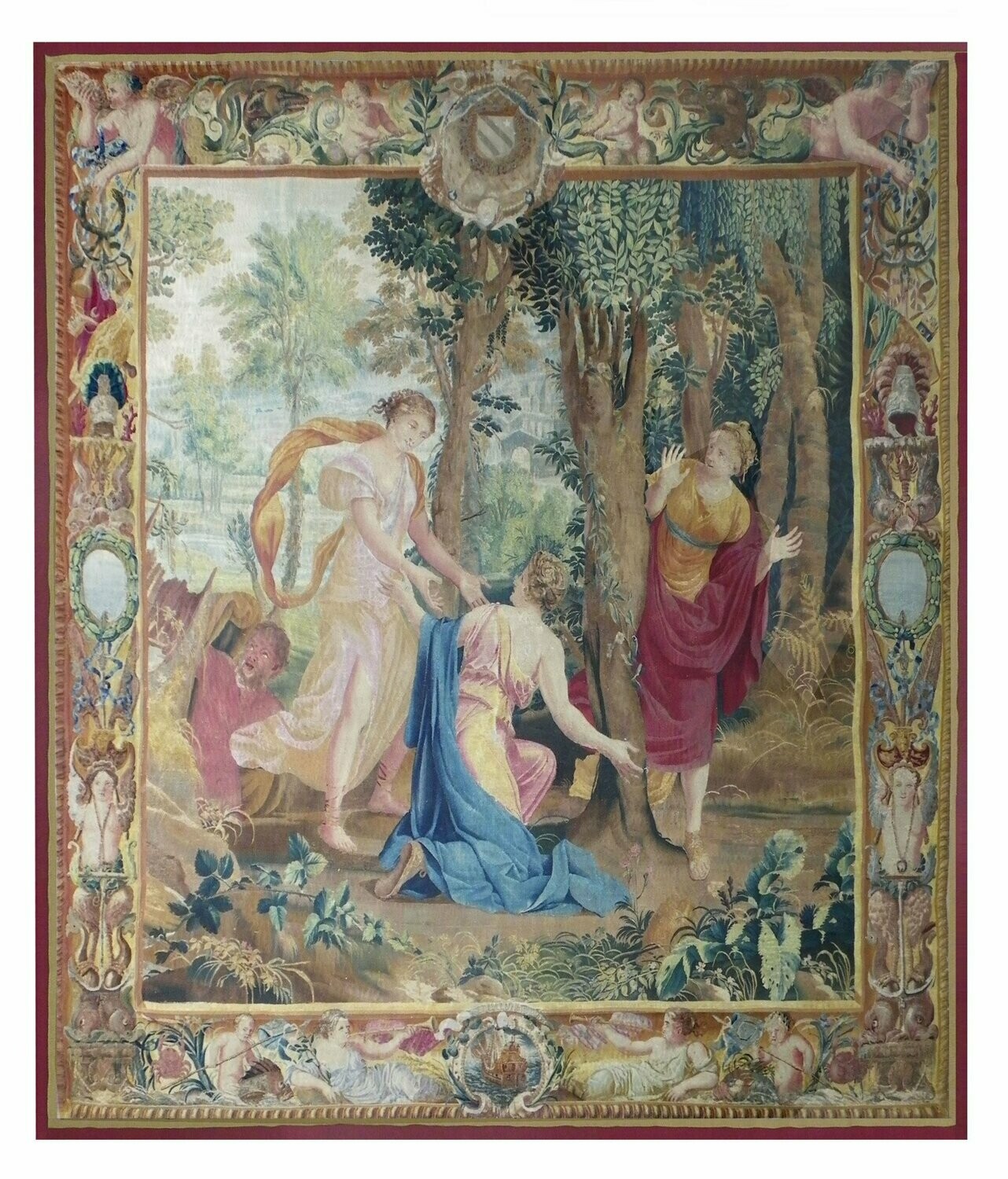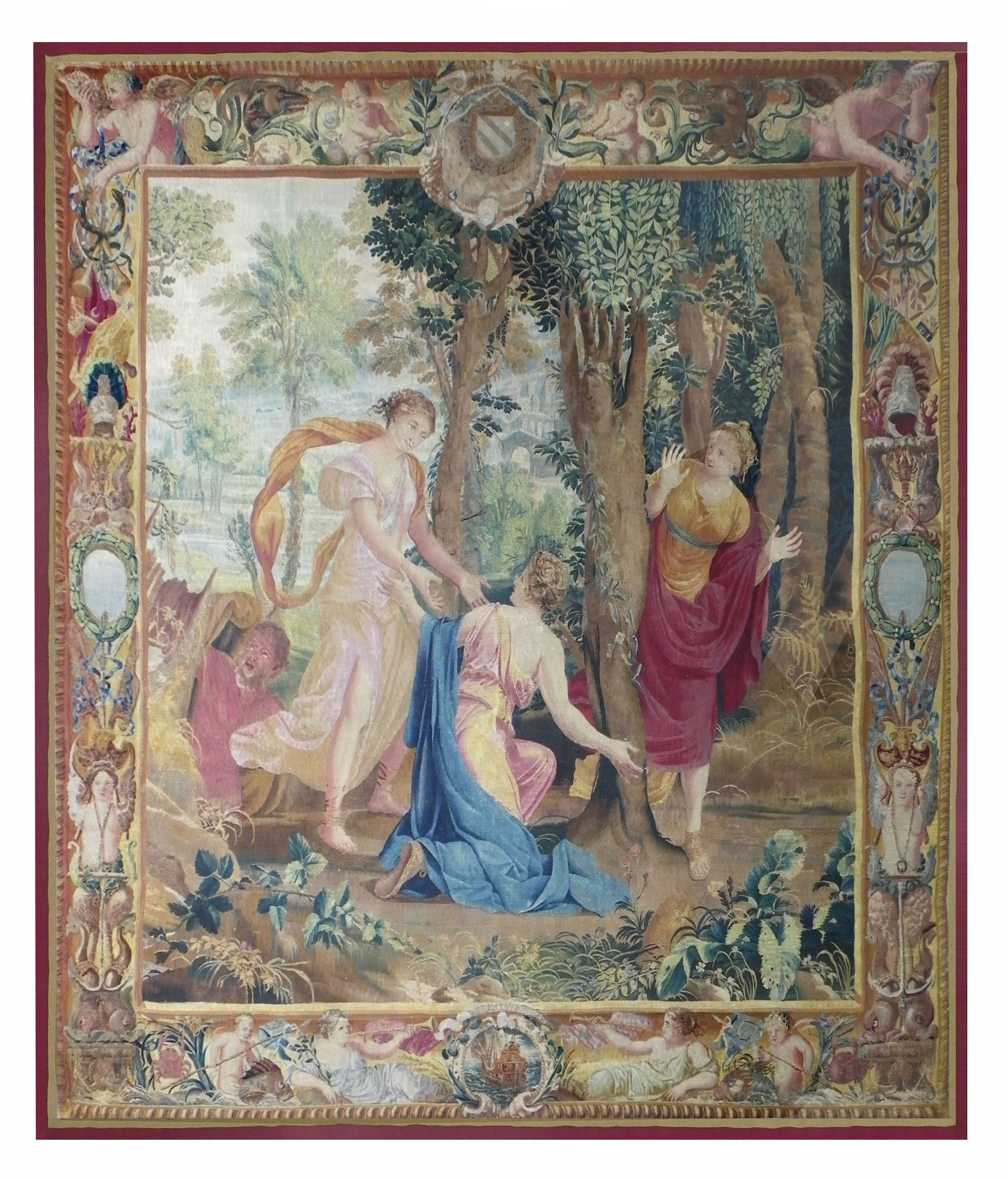Tapisserie parisienne - Métamorphose d'Ovide - Epoque 17e siècle - Dim:L285xH320
N° de référence :78J/ 2752
Origine : France - Atelier de Paris
Époque : 17ème siècle
Provenance :Collection Privée
Composition : Laine et soie et fil d'argent
Dimension : L 285 x H320
Tenture des Métamorphoses d'Ovide - Daphné
Exceptionnelle tapisserie de l'atelier parisienne tissée finement au XVIIe siècle en laine, soie et fil d'argent d'après le carton de Poërson.
Les dimensions sont d'origine et une bordure richement décorée encadre cette magnifique tapisserie.
Dans la mythologie grecque, Daphné (en grec Δάφνη / Dáphnê, signifiant « laurier ») est une nymphe d'une très grande beauté. Selon les sources antiques, elle est soit la fille du dieu fleuve de Thessalie Pénée et de la naïade Créuse, de Ladon, ou de Pénée et de Gaïa1.
Son mythe est sujet à de nombreuses interprétations, cependant la plus connue veut que le dieu Apollon et elle furent touchés par les flèches décochées par Cupidon. Apollon poursuit donc Daphné de ses assiduités jusqu'à l'épuisement. Daphné implore son père de lui venir en aide : celui-ci la métamorphose en laurier pour déjouer Apollon.
Dès lors, Apollon voua un culte au laurier. Lors des Jeux pythiques, organisés tous les quatre ans à Delphes en l'honneur d'Apollon, des couronnes de laurier cueillies dans la vallée de Tempé étaient distribuées comme prix. Cela devint ensuite un symbole de victoire pour les généraux, les athlètes, les poètes et les musiciens. Le poète lauréat est un bon exemple moderne de ce prix qui, bien que datant de la Renaissance italienne, est toujours distribué dans certains pays anglophones. Selon Pausanias le Périégète, « la tradition qui suppose qu'Apollon fut amoureux de Daphné, fille du Ladon, est, à ce que je crois, le seul motif pour lequel on ait, aux jeux pythiques, adopté la couronne de laurier pour les vainqueurs »1.
La plupart des représentations artistiques de ce mythe se concentrent sur le moment de la transformation de Daphné
Les Métamorphoses (en latin Metamorphōseōn librī, « Livres des métamorphoses ») sont un long poème latin d'Ovide, dont la composition débute probablement en l'an 1. L'œuvre comprend 15 livres (près de douze mille vers) écrits en hexamètres dactyliques et regroupe plusieurs centaines de récits courts sur le thème des métamorphoses issus de la mythologie grecque et de la mythologie romaine, organisés selon une structure complexe et souvent imbriqués les uns dans les autres. La structure générale du poème suit une progression chronologique, depuis la création du monde jusqu'à l'époque où vit l'auteur, c'est-à-dire le règne de l'empereur Auguste.
Fameux dès l'Antiquité, le poème devient un classique de la littérature latine traduit dans le monde entier et connaît une postérité abondante jusqu'à l'époque actuelle. Il a suscité de nombreux commentaires et analyses et a inspiré de nombreux artistes de l'Antiquité jusqu'à nos jours.
Enorgueilli de son exploit, Apollon se moque de Cupidon qui, pour se venger, envoie sur le dieu une flèche pour qu'il tombe amoureux et une sur la nymphe Daphné « pour chasser l'amour ». Apollon cherche alors à la convaincre de ne pas lui résister, puis cherche à la prendre de force, mais Daphné se transforme alors, grâce à son père Pénée, en un laurier.
«Nymphe du Pénée, je t’en prie, arrête ! Ce n’est pas un ennemi qui te poursuit. Arrête, nymphe, arrête ! La brebis fuit le loup, la biche le lion, et devant l’aigle s’envole la tremblante colombe ; chacun se dérobe à son ennemi. Mais c’est l’amour qui me précipite sur tes traces. Malheureux que je suis ! Prends garde de tomber ! Que ces épines cruelles ne blessent pas tes pieds délicats ! Que je ne sois pas pour toi une cause de douleur ! Les sentiers où tu cours sont rudes et difficiles. Ah ! de grâce, modère ta vitesse, ralentis ta fuite, et je ralentirai moi-même. Connais du moins celui qui t’aime. Ce n’est point un sauvage habitant des montagnes ni un pâtre hideux gardant des bœufs et des brebis. Imprudente, tu ne sais pas qui tu fuis, tu ne le sais pas, et c’est pour cela que tu fuis. (...)
Jupiter est mon père. Ma bouche dévoile aux mortels l’avenir, le passé, le présent. Ils me doivent l’art d’unir la lyre à la voix. Mes flèches sont sûres de leurs coups. Hélas ! il en est une plus sûre encore qui m’a percé le cœur. Je suis l’inventeur de la médecine. Le monde m’honore comme un dieu secourable, et le pouvoir des plantes est sans mystères pour moi, mais en est-il une qui guérisse de l’amour ? Mon art, utile à tous les hommes, est, hélas, impuissant pour moi-même !»
«Ah ! Puisque tu ne peux devenir l’épouse d’Apollon, sois son arbre du moins. Que désormais ton feuillage couronne mes cheveux, ma lyre et mon carquois. Tu seras l’ornement des guerriers du Latium, lorsqu’au milieu des chants de victoire et d’allégresse, le Capitole verra s’avancer leur cortège triomphal. Et de même que ma longue chevelure, symbole de jeunesse, sera toujours respectée des ciseaux et des ans, je veux aussi parer ton feuillage d’un printemps éternel».
La transformation de Daphné en peinture
Les Métamorphoses furent également une source d'inspiration majeure en peinture, depuis la renaissance, le baroque et jusqu'à l'époque contemporaine ; la plupart des peintres majeurs ayant travaillé sur ces thèmes, depuis Diego Vélasquez, Pierre Paul Rubens) jusqu'au xxe siècle avec Salvador Dalí (Métamorphose de Narcisse) et Pablo Picasso (Illustration des Métamorphoses par le peintre).
Apollon et Daphné de Piero Pollaiuolo, 1470–80 (National Gallery, Londres
Apollon et Daphné de Paul Veronese, 1560–65 (Musée d'Art de San Diego
Apollon et Daphné de Pierre Paul Rubens, 1636 (Musée Bonnat-Helleu, Bayonne
Apollon et Daphné de Nicolas Poussin, 1661–1664 (Musée du Louvre, Paris
Music : Georg Friedrich Haendel - Daphne (voir le vidéo dans l'album photo)
Notre maison vous assure la vente d'une tapisserie avec facture et expertise agrée, bien nettoyée, en bon état avec son système de fixation. Si cela devait être nécessaire, nous vous préciserons les travaux qui ont été effectués. Toutes nos tapisseries peuvent vous être présentées à votre domicile en France et pays limitrophes avant votre décision définitive.




